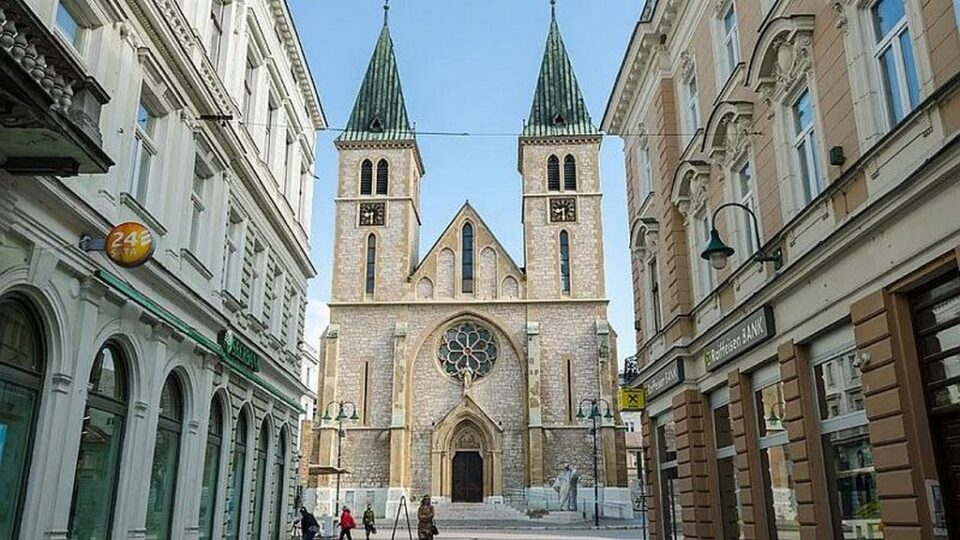On the occasion of the announcement that the Sarajevo City Council have voted to establish February 1st, 1462, as the founding date of the capital of Bosnia and Hercegovina, the Archdiocese of Vrhbosna have issued a press release, which we present in full:
The Archdiocese of Vrhbosna, whose official name is Vrhbosna – Sarajevo (Vrbosnensis seu Seraiensis), feels a moral obligation to make a statement regarding the announcement that the Sarajevo City Council will declare February 1st, 1462, as the founding day of the city.
Namely, it is clear that the then conquerors took over the settlement (city) of Vrhbosna (civitas Vrhbosna), which existed under that name at the site of Sarajevo centuries before that. (KTA BK BiH: Stara katedrala Svetog Petra u Vrhbosni”, 6. Siječnja 2011.; Marko Vego i drugi). The memory of this is preserved in the official name of the Archdiocese, which originates from the Middle Ages: Vrhbosna.
I. In the old Vrhbosna, there was also the Cathedral of Saint Peter, founded in 1238. Based on archaeological findings, regarding the location where it stood in present-day Sarajevo, the discovery of five Romanesque capitals found in Podtekija and the altar dedicated to the apostle Peter, discovered near the former Kemaludin Mosque, helps confirm this. Both findings date from the 12th/13th century.
The discovery of five capitals in the immediate area of the former Skenderpasa Tekija indicates the existence of some religious structure in pre-Ottoman times at that location. Since Skenderija is located at the foot of Debelo Brdo, on the left bank of the Miljacka River, opposite the medieval Vrhbosna, it is possible to locate the Cathedral of Saint Peter in that area, which a charter from King Bela IV in 1244 (Marko Vego) “in supra Vrhbozna Burdo = on the Hill above Vrhbosna.” That would be one of the possible locations.
The second monument, the altar from the Cathedral of Saint Peter in Vrhbosna. Also contributes to the location of this cathedral, but in a different place. This altar was discovered in the courtyard of the Kemaludin (Cemalusa) Mosque, deep in the ground. It is a fragment of an ancient pillar, used in the Middle Ages as an altar, into the upper surface of which a partially damaged dedicatory inscription was carved:
(apost)OLI PETRI VERB(osnensi)
NON POTEST PONER(e)
(hoc o)PU(s)
This discovery of the altar places the old Vrhbosna cathedral at the intersection of the streets of Cemalusa and Ferhadija. Its original is kept in the National Museum in Sarajevo. A copy of it was placed as part of the pulpit in the current Vrhbosna Cathedral, and its stylized design appears in the coat of arms of the Archdiocese of Vrhbosna.
II. In addition to archaeological finds, some written documents about the cathedral in Vrhbosna should also be mentioned. Thus:
- On April 26th, 1238, Pope Gregory IX. informs the Cuman bishop that he should consecrate the new Bosnia bishop Ponsus (or Povsa), after Bishop Ivan thanked for their service. The letter contains this sentence: “Ceterum quod ipse, postquam loco prefuerit, necnon instituendi per te prepositus et capitulum future cathedralis ecclesiae, ac terrae clerus…” = Moreover, as for him personally, after he has been placed in the position, as well as the appointment by you and the chapter of the future cathedral church and the clergy of the land…
- On December 22nd, 1238, Pope Gregory IX. orders the Dominicans in Pecs to give the money that Ban Ninoslav deposited with them for the construction of the cathedral to Bishop Ponus.
- Also on December 22nd, 1238, the same pope orders the Benedictine abbot in Varadin to give the money that the Slavonian Ban Jula left with him for the construction of the cathedral in Vrhbosna.
- Then, on December 7th, 1239, Pope Gregory IX. confirms to the Bosnian bishop and chapter the estates that Duke Koloman and other people donated to him. The letter is addressed: “Venerabili fratri episcopo et dilectis filiis capituli sancti Petri in Bosna” = To the honorable brother bishop and dear sons of the chapter of Saint Peter in Bosnia. The bishop then receives possession of, among other things, the Hill in Vrhbosna and Đakovo in Slavonia. This donation will also be confirmed again in 1244 by King Béla IV.”
- Then, on December 27th, 1239, Pope Gregory IX. orders the Bosnian Dominicans to give the money to Bishop Ponsus that Ban Ninoslav “quondam apud vos pro cathedrali ecclesia construenda in Bosne partibus deposuerit” = once deposited with you for the construction of the cathedral church in the regions of Bosnia.
- On July 20, 1244, King Béla IV. confirms the donation of Duke Koloman from 1239, after the donor had passed away and the land had been devastated by the Tatars. He specifically mentions the possessions of the Bosnian bishop, including, among other things: “in supra Vrhbozna Burdo, cum omnibus pertinentiis, ubi ipsa ecclesia cathedralis sancti Petri est fundata.” = on the Hill above Vrhbosna, with all its appurtenances, where the cathedral church of Saint Peter is founded.
III. The stone remembers, and documents likewise record. Everything else opposes the truth. Or, simply put: Contra artefacta et documenta non sunt argumenta! Moreover, Vrhbosna is not the beginning of the City, as the area of Sarajevo has known settlements continuously since ancient times. This is evidenced by numerous archaeological sites. Vrhbosna is among them. And when it was established, only God knows. But it must have been some form of organized settlement because the Catholic Church, according to ancient rules, only founded dioceses and built cathedrals in such settlements.
Sarajevo, February 17, 2025.
The Archdiocese of Vrhbosna
